Distillation is the most commonly used method for extracting essential oils, and is divided into two methods: "Steam Distillation" and "Water Distillation". In fact, according to many medicinal books, distillation is the only way to extract essential oils. Those obtained by other methods are called essence or original essence.
Steam distillation method: Plant materials are mostly placed on the sieve rack in the distiller. Generally, plant parts such as flowers and leaves can be placed directly (if they undergo other processing, the composition of the essential oil will change, such as: rose, lemon balm , are relatively fragile and cannot be processed. However, some plant essential oils are different, such as chamomile, which need to be dried first.) Then at the bottom of the container, low-pressure heating and burning steam is poured upward. When the hot steam fills the container and surrounds the plant, the essential oil will break through the oil storage cells of the plant and be released. As the water vapor passes through the condenser tube above, it is finally introduced into the condenser. The condenser is a spiral tube surrounded by cold water, which can cool the steam and convert it into water. Finally, it flows into the collection bottle at the bottom, and is separated into essential oil and floral water (or floral water) according to the difference in specific gravity and density. Called pure dew, pure honey). The disadvantage of this method is that the temperature of the distillation method is too high, which can easily destroy some of the more fragile components in the essential oil. This makes the aroma of the extracted essential oils different from the aromatic essence contained in the original plants, especially the ginger and black pepper essential oils. The odor of some pungent plants that originally had a strong and pungent smell is often destroyed by the heat of distillation.
Some essential oils may need to be re-distilled to extract important components. This method is called "reflux distillation" (Cohobation). For example, after distillation of roses, the water-soluble "Phenethyl alcohol" in the roses is extracted. alcohol)" will remain in the flower water, so the rose water has a strong rose smell, but the rose essential oil is missing the most important ingredient, so the rose water must be distilled again to remove the "phenylethyl alcohol" , and then put it back into the essential oil obtained from the first distillation. At this time, the result of the two distillation processes became the famous "Rose Otto".

If some essential oils, such as eucalyptus and melaleuca, still contain impurities after initial distillation, they need to be distilled one or more times to ensure they are pure and free of impurities. This method is called "distillation method" ( Rectification Distillation) This is a re-distillation process that, in addition to removing trace residues such as dust, can also reduce concerns about pesticides or herbicides.
However, from an aromatherapy perspective, distilled essential oils do not necessarily have better quality and efficacy.
In addition, some essential oils rely on the distillation time to determine the grade of the essential oil, using the "Fractional Distillation" method.
For example: Ylang Ylang oil
The ylang ylang oil that is steamed out in the first hour is called Ylang Ylang extra.
The second time, about two or three hours later, the distillation collected is called Ylang Ylang 1st.
The third time, about three or four hours later, what is collected in the distillation is Ylang Ylang 2nd.
The last, usually more than one day, the fourth distillation is called Ylang Ylang 3rd.
The highest quality grade is the first distilled special grade ylang ylang oil!

"HYDRO-DIFFUSION or PERCOLATION"
Although this extraction method appeared later than the "carbon dioxide extraction method", it actually evolved from the "steam distillation method" - its extraction method is similar to the Italian coffee pot - the steam penetrates through the plants from top to bottom. , after entering the cooling system along the conduit, the steam will condense back to the liquid state, and essential oils and flower water can be obtained.
This method is not yet generally popular, but it is very suitable for refining essential oils from woody or strong plant tissues, such as extracting essential oils from seeds of anise, fennel and other plants. It takes twelve hours to extract these essential oils using the general distillation method, but only four hours using the diffusion osmosis method. Shorter production times are not only more economical, but also result in higher quality essential oils.
If the essential oil needs to be refined again to become purer, or if the color turns black, it can be refined by vacuum distillation. The steam is only used for heating and does not come into contact with the essential oil.
Water distillation method: It can be divided into two types according to the level of plants and water level.
1: Water distillation
Water distillation is to place the materials to be distilled on the sieve plate in the distillation pot, and pour clean water under the sieve plate. The liquid level of the clean water should not come into contact with the materials. You can use fire to directly heat the water in the pot, introduce high-temperature water vapor to heat the water in the pot, or use an electric jacket to heat the water in the pot to generate steam for the purpose of distillation. Because there is no real contact between the plants and the water, it is more like the steam distillation method.
2: Distillation in water:
Water distillation is to put the materials that need to be distilled into a distillation pot, and fill the pot with clean water. The ratio of clean water to materials varies depending on the materials. You can use fire to directly heat the water in the pot, introduce high-temperature water vapor to heat the water in the pot, or use an electric jacket to heat the water in the pot to boil the water to generate steam to achieve the purpose of distillation.
When using hydrodistillation, the plant material is completely soaked in water and then heated. The presence of water can avoid overheating of essential oils and ensure the quality of essential oils. This method uses relatively low pressure and temperature, so it is especially suitable for heat-sensitive essential oils such as orange blossom and rose. However, due to the slow process of water distillation, it is not suitable for essential oils that will be damaged if exposed to hot water for too long, especially those with high ester content (lavender, etc.).
Stainless Steel Mixing Equipment Application
Plate Centrifuges Application
Esterification Reaction In Fragrance Synthesis
Contact: Project Manager
Phone: +86-18120438367
Tel: +86-18120438367
Email: info@tycoretech.com
Add: No. 1, Optics Valley Avenue, East Lake New Technology Development Zone, Wuhan, Hubei, China
We chat
